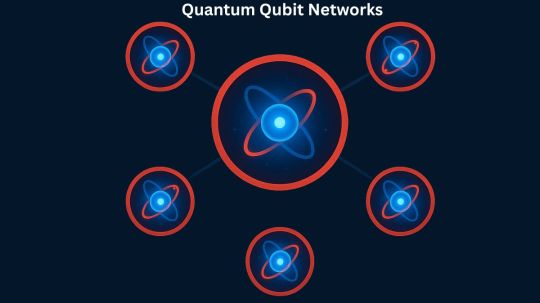#QubitNetworksLinkedviaPhotons
Explore tagged Tumblr posts
Text
Quantum Qubit Networks Future of Computing & Communication

Modern technology uses “qubit networks” to describe interconnected systems with “qubits” as key components. Even though “Qubit Network” is used in many technological domains, quantum qubit networks are vital for quantum computing and sensing. The most well-known and current research centres on them. These quantum-based networks do complex tasks beyond traditional computers.
Quantum Qubit Network Architectures and Capabilities
The architecture of interconnected qubits in quantum qubit networks affects their performance. Researchers are studying how topologies affect a system's ability to maintain quantum coherence and provide valuable functionality for sensitive sensing and powerful information processing. This field struggles with environmental decoherence, or the loss of quantum information.
Superconducting Qubit Networks for Sensing and Processing
Superconducting circuits, especially flux qubit circuits, can enable reliable and scalable quantum technologies. Recent research show that qubit arrangement considerably influences their ability to process information and detect magnetic fields.
Effect of Network Topology Research on superconducting flux-qubit networks' linear and cross-shaped designs is crucial. Research shows that cross-shaped networks are more magnetic flux-responsive than linear arrays. The “network effect” and cooperative interactions between core and peripheral qubits in the network cause this enhancement, not merely adding qubits.
The cross-shaped array's connection design is crucial for collective behaviour that boosts sensitivity. Topology impacts magnetic response through qubit inductive coupling.
Computer Methods and Design Criteria
Researchers employed advanced computational methods to study how qubit arrangement affects magnetic response in these networks. Instead of manufacturing devices, accurate diagonalisation was used to model the networks' energy levels and responses to external stimuli.
Linear response theory and exact diagonalisation were employed to characterise dynamic activity, revealing the networks' processing and detection capability. This computational technique explores the design space, finds ideal configurations, and establishes quantitative design criteria for function-oriented superconducting quantum circuits.
Two-purpose: Reservoir Computing and Quantum Sensing Topologically constructed networks are powerful information processors and sensitive electromagnetic sensors.
Quantum sensing: By carefully managing the qubit structure, researchers can increase the system's ability to detect weak electromagnetic signals. Compared to simpler designs, these networks detect external magnetic fields better.
These networks perform well for reservoir computing, which allows direct data analysis in addition to sensing. One physical device can process and detect signal information. By using these qubit arrays' complicated, high-dimensional dynamics to compute directly in the sensor, signal reconstruction and problem-solving are conceivable without additional processing units.
This integration could lead to smaller, more effective quantum devices that solve difficult problems in materials research and medical diagnostics by speeding quantum information processing. Modelling these systems allows rapid prototyping and optimisation, speeding up quantum technology development.
Photon-Linked Qubit Networks
Photonically linked qubit networks, which enable quantum networking, are another key research field. Distributing pairs of entangled qubits among remote quantum processing nodes does this.
Mechanism and Improvement: Each node in these networks uses photon-interacting communication qubits to transfer quantum data. Cavity Quantum Electrodynamics (CQED) increases qubit-photon interactions, enabling advanced protocols.
Performance Advantages: Researchers are studying these protocols' speed and fidelity in relation to the photonic degree of freedom employed to transport quantum information and crucial device parameters. Strong-coupling protocols in photonically coupled qubit networks can increase distribution rates by 30-75% while maintaining high fidelities (around $\mathcal{F}\gtrsim99%$) compared to two-photon interference methods. This suggests a high-performance quantum communication method.
Other “Qubit Network” Companies
Because “Qubit Network” is employed in non-quantum contexts, there may be ambiguity.
Qubit (QBT) coin: QBT coin is a separate digital asset, unlike quantum qubit networks. Qubit (QBT), its native cryptocurrency, has a one billion coin limit that cannot be increased. Some sources report 0 QBT circulating supplies, while others report 1 billion. On March 26, a new airdrop would give users daily mining money on the Qubit Network mainnet, expected to launch in Q2 2025. Qubit's (QBT) market value is $6,311,345 and its price fluctuates at $0.0001978 USD.
IT company Qubit Networks
The company “Qubit Networks” provides networking, security, and managed IT services. Their products include:
Networking: providing switching, routing, and reliable wireless technologies to move data rapidly, efficiently, and safely.
Network security involves developing secure networks and providing the knowledge and resources to safeguard digital assets and network environments.
Server/Storage: handling data storage, backup, and archiving and servers that provide resources, data, and services.
Premium Support: 24/7 support to enhance network efficiency and reduce customer costs.
In conclusion, quantum qubit networks, which are necessary for quantum sensing and information processing, dominate the scientific debate, even though “Qubit Networks” can also refer to an IT service provider or a cryptocurrency. Topological design is crucial for superconducting and photonically coupled quantum networks to improve efficiency and enable integrated quantum technologies.
#QuantumQubitNetworks#QubitNetworks#Qubit#SuperconductingQubitNetwork#QuantumSensing#Photons#QubitNetworksLinkedviaPhotons#technology#technews#technologynews#news#technologytrends#govindhtech
0 notes